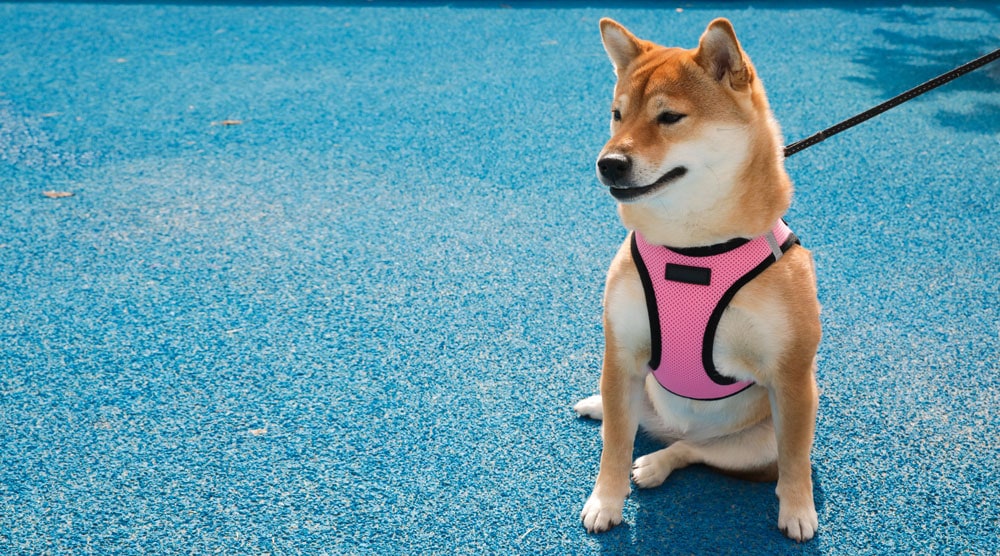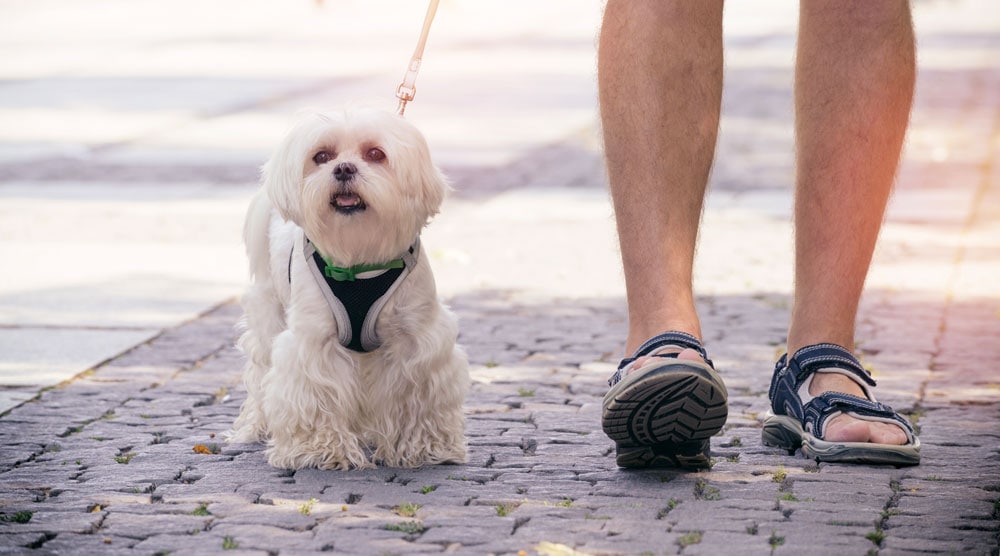Would you describe your pet as a fearful dog? And does he run away when you try to put on his dog harness?
Contents
Editor’s Note: This article is specifically about harness training a fearful dog. These dogs are scared of many objects, items and situations, which is why training progress can be slow. The training method below can be used for any dog who hates their harness though.
Why Use a Harness If Your Dog Is Scared to Wear It?
A dog harness is a much safer way to walk your dog compared to a traditional dog collar.
Personally, I would never attach a leash to any collar. Besides choking, tightness around a collar can lead to issues such as neck injuries, hypothyroidism, foreleg lameness, eye and ear issues and excessive paw licking.
Of course, your dog doesn’t understand this – and training a fearful dog to wear a harness can be challenging. One day you may feel you’re making great progress, and the next he takes a step back. This roller-coaster ride is very normal when training and living with a fearful dog. And the best news, there’s hope!
Why Are Fearful Dogs Afraid of Touch?
Fearful dogs can be a black box that we don’t always fully understand.
Some dogs who are afraid of touch have been physically abused, reprimanded or subjected to possible physical injury or pain. Others just didn’t receive adequate puppy handling and socialization during their critical socialization period.
I would highly recommend a head-to-tail physical with your dog’s veterinarian to ensure he does not have any underlying injuries. Even if your dog had a veterinarian exam in the past, it’s always a good idea to inform your vet that your dog has issues with touch and letting you put on his harness.
Be aware that an examination can be extremely distressing for a fearful dog, so discuss how best to approach it with your vet.
How to Teach Your Nervous Dog to Enjoy His Harness (4 Steps)
If your dog has no medical issues, the process below can teach him to enjoy his harness, rather than fear it.
You’re going to use desensitization and counterconditioning to teach your dog his harness is a good thing:
- Desensitization is a technique that exposes your dog to the harness at such a low intensity that he doesn’t respond. Over time, you gradually increase the difficulty of the stimulus until there is no response.
- Counter-conditioning is classically conditioning your dog to think of his harness as a pleasant thing, often by pairing it with a treat reward.
These dog training techniques work best together, and can quickly transform your dog’s harness from something negative to something positive.
With a fearful dog, it’s extremely important to go slow. Be positive, gentle, and have a lot of patience.
Training Step #1 – Do You Have the Correct Dog Harness and Fit?
Unlike dog collars, harnesses are not created equal. Even the best dog harnesses don’t fit every dog’s body type.
The first step is to ensure you have the proper size of dog harness. The manufacturer will have a diagram showing how to measure your dog properly, so make sure you follow this closely.
Next, you want to make sure the harness has a comfortable and safe fit. Not too loose, not too tight.
For most harnesses, you should be able to slip your fingers between your dog and the harness on all parts of his body, but not able to lift up to create a big opening. This fit should be basically the same while your dog is sitting, walking, or lying down.
The type of harness is also important. You may have purchased a high-quality, durable harness, but if it’s too bulky your shy dog may not feel comfortable. He might also feel he can’t move away quickly if he’s scared.
For fearful dogs, look for a light harness that allows full range of motion. Padded straps can increase comfort, but avoid heavy padding as this can feel restrictive to a fearful dog. Make sure your pet can’t “back out” of the harness, as a nervous dog may bolt and be difficult to find.

PRO TIP: You’ll still need to walk your dog during his desensitization and counterconditioning program, so use a different harness for this. It’s important that your dog only has positive experiences with his “real” harness.
Training Step #2 – Desensitizing to His Harness
Place your dog’s harness in the room you and he spend the most time in.
The harness should be in a spot where he can see it, but not in a location where he has to pass by. You don’t want the harness disrupting his normal activities. It’s just there, part of the décor.
Training Step #3 – Inactive Counter-Conditioning
When your dog is out of the room, place a variety of healthy dog treats around the harness. Make sure some are close to the harness, while others are far enough away that your dog will surely go up and eat them.
Don’t show or engage your dog during this exercise. This is him finding the treats at his own pace, doing what he feels comfortable doing. No pressure, no encouragement.
Continue this process until your dog doesn’t feel scared to eat treats near the harness.
Training Step #4 – Active Desensitization and Counterconditioning
Now it’s your turn to step into the game. Make sure you practice each of the phases below until your dog is comfortable, before moving onto the next.
Phase 1: Creating Positive Associations With the Harness
Sit on the floor with your dog and harness. Place the harness in your hand, while keeping your hand low and off to the side, away from your dog. With your other hand, give your dog three treats in succession. With a playful, happy voice, tell him how handsome and smart he is for being in the same proximity as his harness.
Repeat this process for five more treat sessions.
If he seems nervous, place the harness on the floor farther away. The goal is to ensure your dog is comfortable and taking treats. If he’s happy and comfortable, continue to the next step.
Phase 2: Moving the Harness Higher
With the harness in your hand and off to the side, gently lift the harness up five inches, followed by your dog’s five-treat regimen. Lower your harness hand and repeat by lifting the harness again, followed by giving your dog his treat rewards. Once again, continue this process for five sessions.
Over time, build on this until you’re lifting the harness up to the height of your dog’s head. You are not moving the harness toward your dog, just focus on height.
Phase 3: Moving the Harness Towards Your Dog
As your dog progresses through his training of the harness being lifted up, now it’s time to start to move the harness closer to his head. However, start with the harness low again.
With the harness low to the ground, instead of lifting upward, move it five inches closer to your dog followed by his five treats and words of encouragement and praise.
After his treats, move the harness back to the starting position. Repeat this set five more times. I think you’re starting to get the idea! You’ll continue this until you’re touching your dog’s leg with the harness.
You’re almost there. Now that your dog is happy with the harness touching his leg, lift the harness up from his leg toward his head. Let him look and sniff the harness. This is your next big step.
Stay at this step until your dog seems totally comfortable with this harness next to his face, looking at it, smelling it, getting treats.
Phase 4: Getting Your Dog to Wear the Harness
Now it’s time! With a treat in your hand, place your hand through the head of your dog’s harness and give your dog the treat. As he’s eating the treat, slip the harness over his head and treat him again. Continue with this step until it’s easy.
Once you are able to do this step easily, buckle the harness clips, attach his leash, and you’re ready to go off on an adventure.

PRO TIP: Many dogs hate harnesses that pass over the head. Step-in harnesses or those that clip around the neck and body can be useful alternatives.
Summary
Training a fearful dog to wear a harness may take days, weeks or even months. Don’t feel you’re doing it wrong or the training is hopeless. The time you put into teaching your dog that the harness is a safe and positive experience is worth the effort in the long run.
Be aware that fearful dogs are often chronically stressed though – and wearing a harness is just one example of a fear trigger. It’s critical to address your pet’s fears with a professional, as it’s unhealthy for a dog to live in a constant state of stress.




